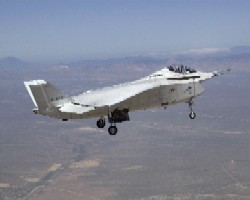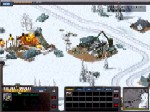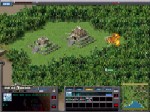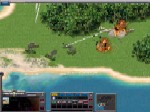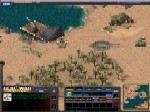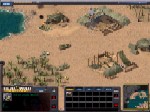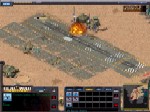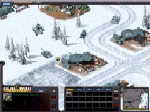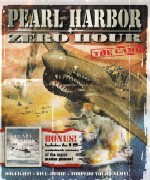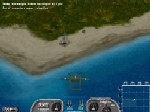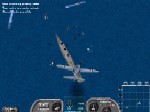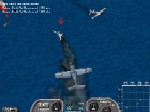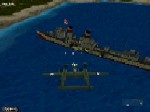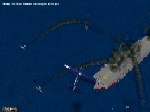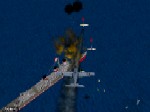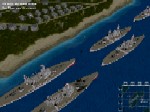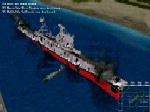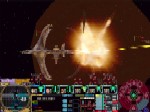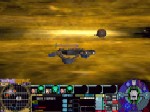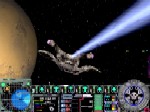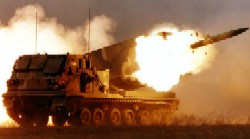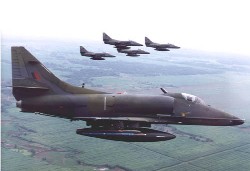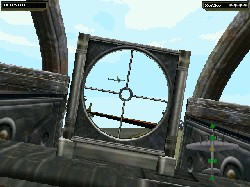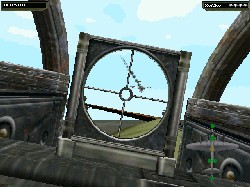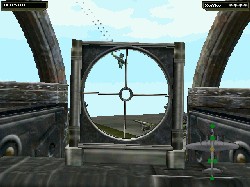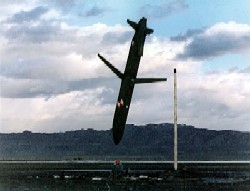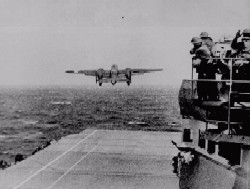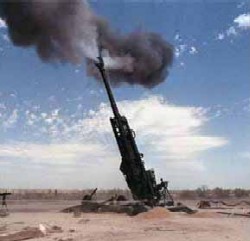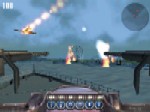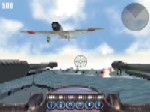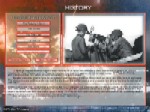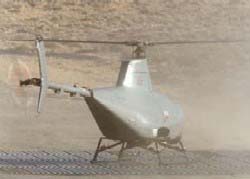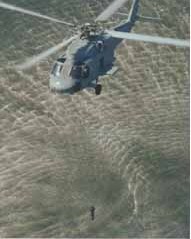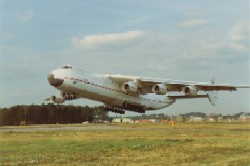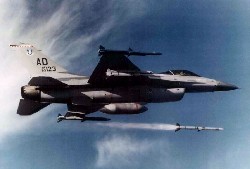Page 1
Daily News
By Gail Helmer
| Send Us News | Archives | Main |
Friday, May 11, 2001
- Fighting Steel Project V3.0 Released
- Steel Beasts Patch 1.15 Released
- IL-2 Sturmovik Friday Update
- Aces High 1.07 Update
- JSF X-32B Flies To Patuxent River For STOVL Testing
- Boeing Chooses Chicago For New HQ
- Boeing Awarded Super Hornet Logistics Support Contract
- US Army Gets New M1V Tank Simulator
PC News
Fighting Steel Project V3.0 Released
The Naval Warfare Simulations Team has released the first of a series of unofficial patches and add-ons for Fighting Steel. Fighting Steel Project V3.0 is one of the most comprehensive and detailed updates ever designed for this simulation. In this latest update major work has been done to enhance the gunnery and damage system which make serious advancements in the realism and accuracy of the simulation. FSP V4.0 is already underway with even more enhancements to the gunnery mechanics as well as other major updates. Future versions will also include higher graphics resolutions, French and Italian WWII navies, naval units dating from 1890 - 1945, and much more. Click here to visit Naval Warfare Simulations, and to download the first of these major updates, FSP V3.0!
Steel Beasts Patch 1.15 Released
eSim Games announced today that the latest patch for Steel Beasts (non-retail version), is now available. Patch 1.15 fixes over two-dozen small problems, and adds over a dozen new features, including passwords for mission editing, and custom text messages for events. A complete list of fixes and new features can be found at eSim Games' web site, as well as in the ReadMe file included in the patch. Click here to download at their web site.
IL-2 Sturmovik Friday Update
This weeks update, from Oleg Maddox, includes screenshots of new settings menus, and a new AI aircraft in action. Editor's Note: There will be no update next as Oleg Maddox's will be showing IL-2 off at E3, which takes place May 17-19 in Los Angeles. Click here for this weeks update.
Aces High 1.07 Update
HiTech Creations has released the latest news on Ace High 1.07 update. The Il-2 is nearly complete and 1.07 is armed with the 23mm cannons in addition to bombs and rockets.1.07 will have the two LVT's done and these vehicles will only be available from the fleet and their spawning mechanism is different than other vehicles. The LVT's only make about 7-8 mph in the water so they need to be dumped off fairly close to shore to have any use. So instead of having a spawn point a fixed distance from the fleet, they will use a dynamic one that automatically sets the launch point a fixed distance from the shore. The only requirement to have this work is that the fleet has to be within a certain range of the base. If the fleet is within that distance, launching an LVT will place you a fixed distance offshore between the base you're attacking and the fleet you launched from. The distance the carrier must be from the base and the distance the LVT is spawned from the shore are settings we're still experimenting with.
The LVT(A)2 is the troop carrier. The LVT(A)4 doesn't carry troops but has a short-barrel 75mm howitzer in an open-topped turret.
HiTech Creations is also making some changes to their airfield layout. The hangar layout is being broken up so they're not clustered for easy attack. They are also making some of the AA guns player controlled like the ones on the ships. Certain bases will also have fortified heavy artillery nearby for fleet defense.
They are also planning changes to the rotation of the terrain in the main arena. Instead of rotating them through at the end of the tour, they'll be rotated when the war is won. This will allow more terrains in the rotation and keep things changing often. It will also allow them to experiment with different terrains more easily. This probably won't be in place with the 1.07 release but should be enabled sometime during the period that 1.07 is the active version.
Military News
JSF X-32B Flies To Patuxent River For STOVL Testing
The Boeing Joint Strike Fighter X-32B today landed at Naval Air Station Patuxent River, Md., on schedule, marking the aircraft's entry into the final phase of a flight-test program that will validate the Boeing direct-lift approach to the program's short-takeoff-and-vertical-landing (STOVL) requirement.
"We're very pleased to be at Patuxent River and expect our test program here to be very successful, as it was at Edwards," said Frank Statkus, Boeing vice president and JSF general manager. "X-32B flight testing at Pax will build on our long and successful history of working with the U.S. Navy in an integrated test team environment."
The flight to Naval Air Station Pax River from Edwards Air Force Base, Calif., follows closely on the heels of a JSF program "first" - airborne transition from conventional to STOVL mode.
Statkus said milestones in the coming weeks, including the first hover and vertical landing, will further prove the company's direct-lift design is simple, reliable, low risk and the best system for the STOVL flight requirement.
"In the conventional mode the X-32B flies remarkably like the simulator and the X-32A," said Maj. Jeff Karnes, U.S. Marine Corps, who piloted the X-32B on its final leg to Naval Air Station Pax River. "We've been able to accomplish a lot of test points in a short period of time due to the quality of teamwork of both government and contractor members of the Boeing integrated flight test team."
The X-32B's first flight on March 29 marked the aircraft's entry into a four-month test program that will include approximately 55 flights totaling about 40 hours. Prior to its flight to Naval Air Station Pax River, the aircraft completed 14 flights for 14.1 hours at Edwards Air Force Base, with five different pilots at the controls.
Dennis O'Donoghue, Boeing lead STOVL test pilot and a former U.S. Marine Corps Harrier pilot, said, "I've now had the opportunity to fly both of our demonstrator aircraft a number of times, and the high degree of commonality in the Boeing design is apparent."
O'Donoghue was at the controls on the X-32B's third and fourth test flights at Edwards Air Force Base when it completed its first in-flight conversions -from conventional to STOVL flight mode and back again. The flow-switch transitions confirmed the ease in conversion as well as the low pilot workload required.
"It's great to be back at Pax," added O'Donoghue, who previously conducted STOVL flight tests with the AV-8B Harrier at the site. "We've got a great test team that includes the Boeing One Team and U.S. and United Kingdom test pilots and engineers, and we're all working toward a common goal.
"We've got great facilities to work with at Pax River as well, including a recently constructed hover pit."
U.S. Air Force Col. Mike Poore, the government JSF Program Office's X-32 program manager, said the arrival of the X-32B is a significant event for the JSF program. "The arrival at Pax is an important milestone for Boeing and its One Team members including Pratt & Whitney (F119-614 engine supplier) and Rolls-Royce (STOVL components including the lift nozzles). The X-32B test program is moving along, and we're looking forward to the upcoming STOVL tests here at Pax."
Boeing used its X-32A aircraft to demonstrate both aircraft-carrier and conventional-takeoff-and-landing objectives. The X-32A completed its flight-test program Feb. 3 after 66 flights and 50.4 flight hours with six different pilots.
Boeing Chooses Chicago For New HQ
The Boeing Company solidified a series of strategic changes to its corporate architecture today by choosing to locate its new world headquarters in Chicago. By Sept. 4, the company plans to begin operations in its new headquarters at 100 North Riverside Plaza in Chicago.
Boeing announced on March 21 a series of changes to its corporate architecture that included plans for a leaner headquarters located separately from its existing businesses. The headquarters staff, which is expected to include fewer than 500 people, will focus on developing global growth opportunities and creating shareholder value. The announcement also elevated to CEO the leaders of the company's three largest business units and gave them broader responsibilities for improving performance and achieving growth objectives.
The Chicago, Dallas-Fort Worth and Denver metropolitan areas were considered as the potential locations for the new world headquarters. John Warner, Boeing senior vice president and chief administrative officer, led an extensive site evaluation process that included visits to each of the three metropolitan areas.
"We looked at three very exciting metropolitan areas in which to base our company. Each community had many positive attributes and would be a suitable location for a corporate headquarters. It was a very difficult decision and no single factor made the difference. In the end, we looked at all the data and made what we believe is the right choice for Boeing," Condit said.
Boeing Awarded Super Hornet Logistics Support Contract
The US Navy has awarded Boeing a $251.9 million, two-year contract to fund a new programme designed to manage and improve logistics system performance. The F/A-18E/F Integrated Readiness Support Teaming (FIRST) programme is aimed at improving readiness and lowering support costs for the Super Hornet. Under the contract Boeing will provide full logistics support of approximately 850 components unique to F/A-18E/F aircraft. The contract contains options, which, if exercised, will bring its cumulative value to a potential $770 million.
"FIRST is an innovative solution designed to provide affordable support for operational squadrons," said Tony Parasida, Boeing vice president for the F/A-18 program.
The Boeing-led Hornet Industry Team and the US Navy expect to generate significant operating and support cost avoidance through effective supply chain management, proactive in-service engineering, sustained reliability improvement, integrated information systems, and the use of an integrated network of suppliers. The integrated supply chain acts as a single company, sharing design and performance information, and linking information-management and decision-making processes. The result is an agile, streamlined support system designed to reduce logistics cycle time, manage parts obsolescence and significantly lower cost.
An industry team led by Boeing builds the Super Hornet. Boeing builds the forward fuselage and wings, and conducts final assembly. Northrop Grumman is the principal airframe subcontractor, supplying the centre and aft fuselage. General Electric produces the F414 engines, and Raytheon builds the APG-73 radar.
US Army Gets New M1V Tank Simulator
Lockheed Martin Information Systems a unit of Lockheed Martin Training, has completed delivery to the US Army in Ft Carson in Colorado of 10 M1V Abrams tank simulators, 5 M2V Bradley Fighting Vehicle simulators, and 2 Dismounted Infantry workstations. These deliveries were worth more than $8 million.
The new Close Combat Tactical Trainer (CCTT) M1V configuration gives the Army increased flexibility by allowing training system conversions to take place in the field. The M1V modules, with enhanced display systems, were delivered in the A1 configuration and modified to the A2 configuration in the field.
"The new M1 variant module increases diversity in the training scenario for the US Army. CCTT is the first simulation system to address the Army's entire combined arms team,'' said Lockheed Martin Information Systems President John Hallal
Under the CCTT contract through the US Army Simulation, Training and Instrumentation Command (STRICOM), Lockheed Martin Information Systems is to perform work in Orlando to be completed by August 2001. The total number of CCTT modules deployed world-wide will exceed 250 with this delivery.
Thursday, May 10, 2001
- MechWarrior 4 Update V1.5
- Infogrames' MacSoft Label to Publish Fly! II
- New Screenshots Real War
- New Screenshots Pearl Harbor: Zero Hour
- New Screenshots Dominion Wars
- Successful MLRS M270A1 Flight Tests
- Raytheon Wins US Army BCT Contracts
- New Zealand's Air Combat Force To Disband
PC News
MechWarrior 4 Update V1.5
Microsoft has released the MechWarrior 4 Update v1.5. The update addresses numerous gameplay issues including the Warping or Increased Lag problem. Click here for the download.
Infogrames' MacSoft Label to Publish Fly! II
Infogrames announced that it has acquired the Macintosh publishing rights to several high-profile titles from Take-Two Interactive Software, Inc. Under terms of the agreement, Infogrames acquires the Macintosh publishing rights to Tropico and Fly! II, which will be shipping this summer, as well as such highly regarded titles as Max Payne, Stronghold and Myth III. Infogrames also obtains the Macintosh rights to several additional titles that will be announced at a later date.
New Screenshots Real War
Based on a PC game developed to train the United States military Real War, is a Real Time Strategy (RTS) game, where you can choose to be the United States or a rogue army called “The ILA” (Independent Liberation Army). Each side controls ground, sea, and air units, with the ultimate goal being to beat your enemy using real, modern-day weaponry. Choose from over 50 (for both U.S. and ILA) different units types – from infantry and armored vehicles, to nuclear subs and attack bombers. You can attack their enemy with M1A1s or T80s or go with Special Forces. You can build Air Force bases so planes can land and provide a facility for them. In addition to F16s and B52s, you will also be able to use psychological warfare on the enemy via a special Psyops plane which will drop propaganda on the enemy or use electronic warfare and reconnaissance planes to eavesdrop on the enemy. Release Date: August 2001. Click on images to enlarge.
New Screenshots Pearl Harbor: Zero Hour
Simon & Schuster Interactive is publishing Pearl Harbor: Zero Hour, set in World War II where you go on bombing and dogfighting missions against Japanese forces. Developed by ASAP Games, Pearl Harbor: Zero Hour gives you arcade-style control over 14 historic aircraft, including the Corsair, P-51 Mustang and B-25 bomber, in 10 missions, such as the Battle of Midway and Guadalcanal. Pearl Harbor:Zero Hour begins with a fully rendered, real-time re-enactment of the Japanese attack on Pearl Harbor, including the sinking of the U.S.S. Arizona. Comes with the complete audiobook CD “Pearl Harbor” by Randall Wallace – the novelization of the highly anticipated motion picture opening Memorial Day weekend. Release Date: May 2001. Click on images to enlarge.
New Screenshots Dominion Wars
Star Trek Deep Space Nine: Dominion Wars is space combat/strategy game that will allow you to blast away against up to eight players online, or test out their skills on one of the 20 single player missions. Dominion Wars will allow you simultaneous control of up to six different ships from any of four different races – Federation, Klingon, Cardassian and Jem ‘Hadar - in real time combat. Players will be able to recruit a range of different ships and captains through the use of a point system and engage in both single and multi-player battles. Release Date: June 2001. Click on images to enlarge.
Military News
Successful MLRS M270A1 Flight Tests
Lockheed Martin Missiles and Fire Control -Dallas conducted three successful developmental flight tests of the Multiple Launch Rocket System (MLRS) upgraded M270A1 launcher this week at White Sands Missile Range, N.M. A total of 23 MLRS rockets were fired successfully from the M270A1 over a two-day testing period.
On May 2, 12 MLRS Reduced Range Practice Rockets (RRPRs) were successfully ripple fired from a M270A1 launcher. On May 4, five MLRS Tactical Rockets were ripple fired from the launcher, followed by another ripple firing of six Extended-Range Rockets. According to preliminary data, all test objectives were achieved.
The M270A1 program is a major upgrade to the MLRS launcher. It includes an Improved Fire Control System (IFCS) that features a Global Positioning System (GPS), as well as the ability to process large blocks of data from new smart munitions within tactical timelines. Operating and maintenance costs will be reduced because of greater reliability and ease of repair on IFCS parts.
The system also incorporates the Improved Launcher Mechanical System (ILMS) upgrade, which dramatically reduces the time needed to aim and reload the launcher. In a typical fire mission, the ILMS-equipped launcher is six times faster than the current M270 launcher. Reload time is decreased by more than 30 percent. Crew and launcher survivability will be greatly enhanced because total exposure time on the battlefield will be significantly reduced.
Raytheon Wins US Army BCT Contracts
Raytheon Company has received $50 million in contracts from the U. S. Army and the GM GDLS Defense Group to supply equipment for the Brigade Combat Team (BCT). Contract options extending through 2006 provide Raytheon a potential $250 million in additional sales. Raytheon's Tactical Systems business unit in McKinney and Dallas, Texas, and in El Segundo, Calif., will perform the work.
Raytheon will produce both government furnished equipment and contractor furnished equipment under the contracts, with products incorporated into the ten variants of the wheeled Light Armored Vehicle (LAV III) for the BCT. GM GDLS Defense Group will produce more than 2,000 of these systems during the life of the contract. The Raytheon contracts will provide:
"The advanced technology Raytheon brings to the program provides the battlefield edge the Army demands," said Colin Schottlaender, vice president and general manager, Tactical Systems. "The cost over the life of the program is significantly reduced by the commonality of components we provide."
- The Driver's Vision Enhancer, which provides the driver with enhanced visibility for night driving or reduced visibility operations.
- The Dual Axis Head Assembly, a component of the fire control system for the 105 mm cannon on the Mobile Gun System.
- High Performance Infrared Equipment II, a Forward-Looking Infrared (FLIR) component of the Mobile Gun System.
- The Modified Improved Target Acquisition System, a second generation FLIR anti-tank system, providing fire control for the TOW missile.
- The Long Range Advanced Scout Surveillance System, a second generation FLIR system providing far-target location and acquisition capabilities.
- The Thermal Weapons Sight (TWS), providing sighting capability for the M2 .50 caliber machine gun and the Mk-19 grenade launcher, which are operated remotely from inside the vehicle.
New Zealand's Air Combat Force To Disband
In a major re-focusing of its defensive priorities, New Zealand is set to disband its air combat force by the end of the year. The 17 A-4 Skyhawks and 17 Aermacchi jet trainers are to be decommissioned in order to release funds to modernise the army and the country's marine surveillance capabilities.
The emphasis of the government's pre-budget announcement was on updating the New Zealand Defence Force (NZDF) in a way that reflected the defensive needs of the country and was financially viable. The $NZ1 billion estimated cost of replacing the ageing Skyhawks was considered too high and approximately $NZ870 million will be saved, over a ten year period, by disbanding the air combat force.
"The simple fact is that New Zealand cannot afford modern combat aircraft and the weaponry needed to equip them, and also maintain adequate army and navy capabilities." Said Defence Minister Mark Burton.
However, the move has received criticism, not only from opposition parties in New Zealand but also from the allies of the country. Australia, as the country with the closest military links with New Zealand, will be affected most by the news. "Every time a country takes a decision about the size and the readiness of its defence force, that decision has both domestic and international consequences," said Australian Prime Minister John Howard.
The focus of the NZRAF, in conjunction with a slimmed down navy, will now be that of maritime surveillance. The government has identified the army as the most likely branch of the NZDF to be involved in an international combat situation, as is currently the case in East Timor. As such it will be the major beneficiary of the $NZ2 Billion investment the government proposes to inject into the defence budget over the next ten years.
"The government has committed to ensuring that our Army is the best equipped it can be, with the most modern capability, suited to a potential future theatre of war in which there will be a high reliance on technology," said Mr Burton. Some of the current equipment being used by the NZDF dates back to the Vietnam War era.
The navy will be streamlined with the retirement of the HMNZS Canterbury and the sale of the HMNZS Charles Upham. The Canterbury is to be replaced by a new multi-purpose vessel to improve New Zealand's coastal protection abilities while refurbishment of the Charles Upham was considered unfeasible and it will be sold after it finishes its current charter. The navy will be supported by the NZRAF's Orion maritime patrol aircraft, which are to be retained. The government will explore the options for increasing the missile capabilities of its remaining aircraft, including the Iroquois helicopters, which are to be updated or replaced.
New Zealand continues to plough its own furrow in terms of world defence. Despite the fact that these changes have been tailored to fit the needs of the country, and that the Skyhawks were never called into combat action, it remains to be seen how far the reverberations of this decision to willingly revoke the capability of combat aircraft will echo.
Wednesday, May 09, 2001
- New Screenshots Real War
- New Screenshots Pearl Harbor: Zero Hour
- New Screenshots Dominion Wars
- Fighter Ace Tournament Underway
- New B-17 Gunner Screenshots
- Hollywood Actor's Voice Of Real War
- Club Gathering Launched
- ICQ Celebrates 100 Million Users
- Major Growth In Online Game Market
- Precision-Strike Accuracy In CALCM
- B-25 Bombers to Make Final Reunion Flight
- Northrop Grumman Counter Offers GD Bid For NNS
- General Dynamics Responds To NG's Hostile Offer
- XM777 Lightweight Howitzer Programme Struggling
PC News
New Screenshots Real War
Based on a PC game developed to train the United States military Real War, is a Real Time Strategy (RTS) game, where you can choose to be the United States or a rogue army called “The ILA” (Independent Liberation Army). Each side controls ground, sea, and air units, with the ultimate goal being to beat your enemy using real, modern-day weaponry. Choose from over 50 (for both U.S. and ILA) different units types – from infantry and armored vehicles, to nuclear subs and attack bombers. You can attack their enemy with M1A1s or T80s or go with Special Forces. You can build Air Force bases so planes can land and provide a facility for them. In addition to F16s and B52s, you will also be able to use psychological warfare on the enemy via a special Psyops plane which will drop propaganda on the enemy or use electronic warfare and reconnaissance planes to eavesdrop on the enemy. Release Date: August 2001. Click on images to enlarge.
New Screenshots Pearl Harbor: Zero Hour
Simon & Schuster Interactive is publishing Pearl Harbor: Zero Hour, set in World War II where you go on bombing and dogfighting missions against Japanese forces. Developed by ASAP Games, Pearl Harbor: Zero Hour gives you arcade-style control over 14 historic aircraft, including the Corsair, P-51 Mustang and B-25 bomber, in 10 missions, such as the Battle of Midway and Guadalcanal. Pearl Harbor:Zero Hour begins with a fully rendered, real-time re-enactment of the Japanese attack on Pearl Harbor, including the sinking of the U.S.S. Arizona. Comes with the complete audiobook CD “Pearl Harbor” by Randall Wallace – the novelization of the highly anticipated motion picture opening Memorial Day weekend. Release Date: May 2001. Click on images to enlarge.
New Screenshots Dominion Wars
Star Trek Deep Space Nine: Dominion Wars is space combat/strategy game that will allow you to blast away against up to eight players online, or test out their skills on one of the 20 single player missions. Dominion Wars will allow you simultaneous control of up to six different ships from any of four different races – Federation, Klingon, Cardassian and Jem ‘Hadar - in real time combat. Players will be able to recruit a range of different ships and captains through the use of a point system and engage in both single and multi-player battles. Release Date: June 2001. Click on images to enlarge.
Fighter Ace Tournament Underway
Microsoft today announced that the USAF Fighter Ace Air Conquest tournament, a massively multiplayer death match event, is now underway on Zone.com. Throughout the month of May, fighter aces will take to the skies in Zone.com's new death match arena, battling for air supremacy and a grand prize of US$2000.
Every Saturday and Sunday in May, USAF Fighter Ace Conquest death match heats will take place on Zone.com at 11:00am and 1:00pm PDT. Winners of each heat will participate in a one-on-one showdown for a US$250 prize and a place in the event semi-finals. Sixteen semi-finalists will enter the death match arena, but only eight will survive to make it to the finals. The USAF Fighter Ace Conquest finals will take place at 12:00 pm PDT on Saturday, June 2, 2001. The winner will be awarded the grand prize of US$2000.
To participate, fighter aces must arrive 10 minutes prior to the death match start time, and pre-registration is not necessary. For more information click here.
In Fighter Ace II, players battle for airborne supremacy by coordinating battle plans with their wingmen and squad mates. Fighter aces must defend their territory, secure new strategic positions, and blast bogies in an on-going war between British, German, United States, Russian, and Japanese aircraft. Fighter Ace II's accurately modeled World War II aircraft include such planes as the DeHavilland Mosquito, the F4U-4 Corsair and the legendary Zero. Players can completely customize the ordnance load-out of their planes including auxiliary fuel, bombs and rockets. With an entirely new physics, flight and damage model, along with aircraft mounted rockets and territorial combat with player triggered tanks, Fighter Ace II brings a level of realism never before experienced in an online-only air combat game. For more information on the game, click here.
Fighter Ace Tournament Underway
Microsoft today announced that the USAF Fighter Ace Air Conquest tournament, a massively multiplayer death match event, is now underway on Zone.com. Throughout the month of May, fighter aces will take to the skies in Zone.com's new death match arena, battling for air supremacy and a grand prize of US$2000.
Every Saturday and Sunday in May, USAF Fighter Ace Conquest death match heats will take place on Zone.com at 11:00am and 1:00pm PDT. Winners of each heat will participate in a one-on-one showdown for a US$250 prize and a place in the event semi-finals. Sixteen semi-finalists will enter the death match arena, but only eight will survive to make it to the finals. The USAF Fighter Ace Conquest finals will take place at 12:00 pm PDT on Saturday, June 2, 2001. The winner will be awarded the grand prize of US$2000.
To participate, fighter aces must arrive 10 minutes prior to the death match start time, and pre-registration is not necessary. For more information click here.
In Fighter Ace II, players battle for airborne supremacy by coordinating battle plans with their wingmen and squad mates. Fighter aces must defend their territory, secure new strategic positions, and blast bogies in an on-going war between British, German, United States, Russian, and Japanese aircraft. Fighter Ace II's accurately modeled World War II aircraft include such planes as the DeHavilland Mosquito, the F4U-4 Corsair and the legendary Zero. Players can completely customize the ordnance load-out of their planes including auxiliary fuel, bombs and rockets. With an entirely new physics, flight and damage model, along with aircraft mounted rockets and territorial combat with player triggered tanks, Fighter Ace II brings a level of realism never before experienced in an online-only air combat game. For more information on the game, click here.
New B-17 Gunner Screenshots
Infogrames has sent us more screenshots from their upcoming title B-17 Gunner: Air War Over Germany Screenshots. B-17 Gunner is based on the real-life parameters and obstacles faced by the men of the American 8th Air Force. B-17 Gunner: Air War Over Germany features 25 missions -- the same number flew by American crews before being rotated home; Jump between nine machine gun positions or control the Norden bomb sight on bombing runs; Defend your B-17 against five different types of realistically rendered Luftwaffe aircraft; Listen to intercom chatter, droning engines, screaming bombs and other authentic combat sounds; Plane encyclopedia offers information and pictures on all aircraft. Release Date: May 11, 2001
Hollywood Actor's Voice Of Real War
Simon & Schuster Interactive has announced that its upcoming real-time strategy war game, Real War, will feature the voice of R. Lee Ermey, the actor best known for his role as Gunnery Sergeant Hartman in Stanley Kubrick's Full Metal Jacket. Ermey will provide the voice for the in-game mission briefings. In addition to his role in Full Metal Jacket, the actor has appeared in numerous other films, including Apocalypse Now, Dead Man Walking, Seven, and Switchback. Before he began his acting career, Ermey spent 11 years in the US Marine Corps, including one and a half tours in Vietnam.
Simon & Schuster's Real War is based on Joint Forces Deployment, a tactical-combat simulation developed for the US military. Players can assume control of either the US forces or a terrorist group known as the Independent Liberation Army, and each side includes 12 scenarios and around 40 hours of gameplay. The game features more than 50 different types of real-life units, including infantry, armored vehicles such as the M1A1 and the T80, nuclear submarines, and aircraft such as the F16 and the B52. Real War is in development at Rival Interactive, and it is scheduled for release in August.
Club Gathering Launched
God Games has created Club Gathering a CD mailing list for people who want to get the first look at all of GodGames' upcoming titles plus game demos,product updates, new music and behind-the-scenes footage segments. The Special E3 Edition of the Gathering of Goodness CD will include all-new videos, a huge demo of Tropico, the final Serious Sam demo and more. There is no cost, click here to join today.
ICQ Celebrates 100 Million Users
ICQ ("I Seek You"), the world's most popular online communications community and international service from America Online, Inc., today announced that it has reached 100 million registered users worldwide.The number of registered users has grown rapidly from zero to 100 million in just over four years, all through viral marketing and word-of-mouth. ICQ attributes its explosive growth and success to several factors, including its pioneering role in offering the first Internet instant messaging software, its heritage of offering consumers the most communications features, and maintaining a unique experience for its users. ICQ was created in 1996 by the Israel-based company, Mirabilis, and acquired by AOL in 1998.
Major Growth In Online Game Market
A new research report from DFC Intelligence forecasts that 95 million people worldwide are expected to be playing online games by the year 2005. Furthermore, online games are likely to be a major driver for the consumer adoption of broadband services. However, what is more uncertain is how much revenue will be generated from online games. According to David Cole, president of DFC Intelligence and one of the report's authors, "Online games should garner significant usage over the next few years. The major question mark is whether individual companies will be able to monetize that usage."
The report features 10 different scenarios for online game revenue growth. "There is plenty of opportunity for money to be made in this space," said Cole. "However, it is uncertain whether the industry as a whole will be able to capitalize on this opportunity."
The report stresses that online games are a product category where consumers should eventually spend substantial sums of money. Online games are also a reason for consumers to subscribe to broadband services. "People will pay for games, and online games are likely to be a key reason that many consumers pay extra for a high-bandwidth service," said Cole.
However, the report also stresses that the online game market is still very much in its infancy. Right now, most companies are losing money in the online game space. Nevertheless, there are already some major online game success stories. According to Jessica Mulligan, one of the report's authors, "Online games have been around for years, but now it looks like some of the online games currently on the market are going to generate well over $300 million in lifetime revenues. With high profit margins, these games will be extremely lucrative for their developers."
Military News
Precision-Strike Accuracy In CALCM
The U.S. Air Force last week demonstrated precision-strike accuracy with a Block 1A Conventional Air Launched Cruise Missile (CALCM) in a flight test at the Utah Test and Training Range. The test also validated advanced Global Positioning System (GPS) processing flight software, which provides the precision delivery guidance. The flight test culminated the three-year development program to upgrade the CALCM with precision GPS-aided inertial navigation.
Block 1A missiles equipped with the upgraded avionics have already been delivered to the Air Force. Under a separate contract, precision accuracy kits are being produced to retrofit the entire CALCM Block 0/1 inventory by February 2002. CALCM is produced by incorporating a conventional warhead into surplus AGM-86B Air Launched Cruise Missiles (ALCM). Under a $59.2 million contract initiated in 1999, Boeing converted 272 surplus ALCMs to conventional blast/fragmentation warhead CALCMs.
Currently, under a $45 million contract, an additional 50 missiles are being converted to a CALCM variant designated as AGM-86D. The AGM-86D uses a penetrating warhead and precision guidance to destroy hardened or buried targets. CALCM is a long-range standoff weapon with more than 200 missiles having been employed effectively in combat. CALCM has become the Air Force's weapon of choice, principally because of its unparalleled ability to deliver very large (3,000-pound class) warheads with exceptional accuracy over distances in excess of 600 miles.
Although the missile has been out of production for 15 years, Boeing has retained a core program group in Seattle, providing logistic and engineering support to maintain and modernize both the ALCM and CALCM fleets. "We're happy to continue supporting the Air Force on the ALCM/CALCM program," said Carl Avila, Boeing ALCM/CALCM program manager. "Although the original ALCM airframe was designed in the early 1980s as a 10-year weapon, it has proven itself as an enduring, dependable product. It is gratifying to see that the CALCM derivatives will remain the mainstay of the Air Force's long-range, conventional strike weapons for the next two decades." (Boeing Photo)
B-25 Bombers to Make Final Reunion Flight
Historic Squadron of Eight-Ten WWII B-25 Bombers to Make Final Reunion Flight Stop at Petersen Aviation Wednesday, May 9, 2001. Petersen Aviation, the private fixed-base operation (FBO) known the world over as the premiere destination for executive aircraft and whose clientele include celebrities in the entertainment and record industries, heads of state, and other notable VIPs, will host a fly-over and landing of one of the largest groups of vintage WWII B-25 bombers remaining airborne today.
B-25 taking off for raid on Japan
The squadron of between eight and 10 classic Warbirds will circle Petersen Aviation and then land for a three-hour refueling stop. The aircraft will be enroute to Fresno, California for their final public reunion of the B25s to celebrate General Jimmy Doolittle's Raid on Japan in 1942.
With the upcoming Disney movie, "Pearl Harbor," starring Ben Affleck, public interest is growing for warbirds and what was once hailed as the best bomber of WWII. The B25 twin engined, twin-tailed bombers were used during the first bombing raids on Japan on April 18, 1942, however only a handful remain flying today.
The impressive squadron of 8-10 B-25s is scheduled to fly in formation over Petersen Aviation and land at the Van Nuys Terminal at 12:30 pm May 9. The squadron will remain on the ground until 3:00pm for refueling and display before taking off for the official reunion in Fresno.
Northrop Grumman Counter Offers GD Bid For NNS
Northrop Grumman Corporation announced today that it has offered to acquire Newport News Shipbuilding, citing concerns that the previously announced merger agreement between Newport News and General Dynamics Corporation would create an unhealthy monopoly, resulting in an unacceptable and anticompetitive consolidation of the U.S. shipbuilding industry.
The Board of Directors of Northrop Grumman has authorized management to match General Dynamics' offer of $67.50 per share for all the outstanding shares of common stock of Newport News, payable 75 percent in Northrop Grumman stock, the remainder in cash. Northrop Grumman said it expects to commence an exchange offer shortly, subject to customary conditions.
In a letter to Newport News Chairman and Chief Executive Officer William P. Fricks, Northrop Grumman Chairman, President and CEO Kent Kresa said that he believes that a "combination of Newport News and Northrop Grumman (which recently purchased shipbuilder Litton Industries) would offer a variety of strategic benefits, including significant cost savings to the U.S. Navy and the opportunity for Newport News employees to become a part of a larger, more diversified company. In contrast to General Dynamics' offer, the product portfolios of Northrop Grumman and Newport News in no way overlap, provide opportunities for efficiencies, and the combination of our two companies would preserve the current competitive landscape of the military shipbuilding industry."
Mr. Kresa also said that the "proposed transaction with General Dynamics raises serious antitrust issues" and, that if permitted to proceed, "would leave the nation vulnerable with only one nuclear capable submarine and ship builder." Mr. Kresa also cited a 1999 Department of Defense analysis that indicated that "over 75 percent of the total shipyard engineering talent and over 95 percent of the Navy R&D investment would exist in a combined General Dynamics-Newport News entity." Mr. Kresa added, "Nothing has changed since that analysis. This would be an unacceptable position for the U.S. government, the Navy and for Northrop Grumman."
"We believe, and we believe that many already agree, that there is enormous national security value for America in maintaining, not eliminating, opportunities for competition between General Dynamics and Newport News. In short, we believe the General Dynamics-Newport combination would endanger national security and be costly to both the Navy and the American taxpayer."
Mr. Kresa said that, "The Board of Newport News has a fiduciary responsibility to seriously consider our offer, as we believe it provides superior overall value and greater certainty of completion than the current merger agreement with General Dynamics."
Northrop Grumman said its cash and stock offer is fully financed. Mr. Kresa said that he would seek a meeting with Mr. Fricks and Newport News' Board of Directors to discuss Northrop Grumman's offer.
General Dynamics Responds To NG's Hostile Offer
General Dynamics issued the following statement in response to an announcement that Northrop Grumman Corporation will make a hostile offer to acquire the outstanding shares of Newport News Shipbuilding:
"We're disappointed that Northrop Grumman has chosen to interfere in a proposed transaction agreed upon by the respective boards of directors of General Dynamics and Newport News Shipbuilding. Northrop Grumman became the dominant player in surface warfare shipbuilding markets through its recent acquisition of Litton. It now seeks to become the dominant player in nuclear shipbuilding as well through a hostile offer.
The combination of General Dynamics and Newport News is the only combination that can provide synergies necessary to achieve significant merger-related savings. It is also the only combination that offers the Navy depth of experience in the safe management of nuclear shipbuilding."
XM777 Lightweight Howitzer Programme Struggling
The programme to develop the new XM777 155mm Lightweight Howitzer for the US army has run into technical difficulties, which are causing significant delays and spiralling costs, according to a report by the United States General Accounting Office. The project is being directed by the Army-Marine Corps Lightweight Howitzer Joint Programme Office with the British Company BAE SYSTEMS (BAE), as the prime contractor.
The new weapon is to replace the M-198 towed howitzer, providing a lighter, more transportable, and more strategically efficient weapon. However, because of problems as diverse as adapting to soil types, and the durability of the optical sight, key deadlines have been put back and development restructuring has increased costs by $120.3 million since July 2000 from $1,129.9 million to $1,250.2 million.
Since the original programme for the development of the weapon was announced in February 1996, production deadlines have continuously been put back. For example, delivery of the first test howitzer was originally to have been June 1998, in reality it did not appear until November 2000 - a delay of 24 months. These delays are despite a rescheduling of the programme by the Joint Programme Office, in accordance with BAE, in December 1998, which in fact delayed the process still further. The production contract award is now expected to be October 2002, 34 months from the original date of December 1999. Initial fielding of the howitzer by the Marine Corps is now expected to be July 2004, rather than March 2002, although the date for the first fielding by the army has not changed and should be March 2005.
These delays have in the main been caused by BAE's ongoing efforts to eliminate technical difficulties. In July 2000 the three main problems were insufficient spade size, flexure of the saddle assembly, and faulty titanium welding processes. While these problems have been addressed, four further technical difficulties have been identified since the last review - spade cracking, spade latch, spade damper and optical sighting.
The spades are critical to the operation of the howitzer because they are designed to dig into the ground in order to stabilise the weapon during firing. After the original spades were found to be too small, larger spades were fitted to the prototype weapon and have been successfully tested in a live-fire situation. However, in August 2000, testing revealed that the firing of the howitzer in very hard soil led to cracking in the lower portion of the enlarged spade. Therefore, BAE have made 14 design modifications to reshape and strengthen the spades but as yet the new design has not been tested.
Furthermore, problems have been discovered with both the latches and the damper mechanism on the spades. Following tests at the Yuma Proving Grounds in December 2000 and January 2001 revealed that the latches, which should release tension from the spades, were coming loose. This caused difficulties in removing the spades from the ground. This is an ongoing problem and improvement tests will be carried out prior to safety tests in June 2001. The spade damper is designed to help orient the spade for proper digging into the ground, but its current incarnation has only one setting for all types of soil type. Again this will have to be modified and retrofitted to earlier howitzers.
A further difficulty is with the optical sights for the weapon. The upgrade of the Army's towed artillery included digitisation, more specifically to the howitzer this meant a precise location and targeting system. However, original programme estimates regarding the adapting of software written for another cannon programme for the XM777 have been proved to be inaccurate. Only 70 to 80 percent of the software is re-usable, rather than the 90 percent originally specified, so a new code will have to be written. As this is yet to be achieved cost and schedule projections have not been made.
The result of these problems with the digitisation upgrade is that the optical sight from the M-198 has had to be modified to fit the new howitzer. However, the lighter weight and greater stresses of the new weapon have proved damaging to the optical sight. A new version has been developed and will be tested under firing conditions on the second developmental gun which was due to be delivered in April 2001.
The increase in costs for the programme is largely attributable to the restructuring of the contract with BAE and the demands of the digitisation development programme for both the Army and Marine towed artilleries. The contract with BAE changed from a cost-plus-incentive fee contract into a cost-sharing contract, increasing from $43.4 million to $65.8 million. According to Programme Office officials this increase of $22.4 million includes $5.0 million for the addition of two pilot production guns, $8.5 million for risk reduction efforts and $8.9 million for extending the programme by one year.
Further production increases could be caused by the cost of the barrels for the howitzer. These are being manufactured separately by the US Army's Watervliet Arsenal, and the cost of cannon barrels fluctuates between $106,000 and $334,000 depending on the workload at any given time. The most recent estimate was between $200,000 and $224,000.
Considering the problems that BAE has had in development, and that 70 percent of the production of the howitzers is to be subcontracted to 5 major United States companies, (United Defence LP, HydroMill Inc, Major Tool and Machining Inc, Rock Island Arsenal, and RTI International Metals Inc) costs and delays seem likely to increase. It may well be some time before the Army can field the 273 guns it plans to buy or that the Marines can demonstrate the capabilities of the 413 howitzers that it expects.
Tuesday, May 08, 2001
- Eurofighter Typhoon Released - Europe Only
- Infogrames Announces Pearl Harbor: Defend The Fleet
- Pearl Harbor: Defend The Fleet Screenshots
- Steel Panthers World At War v5.0 Released
- LRIP Begins For Northrop Grumman's Fire Scout VTUAV
- SH-60R Helicopter Flight Tests AQS-22 Dipping Sonar
- General Dynamics Awarded Virginia-Class Design Work
- Rolls-Royce Wins Australian Submarine Care Package
PC News
Eurofighter Typhoon Released - Europe Only
Eurofighter Typhoon was officially released in Europe on May 4. What about the North American release? COMBATSIM contacted Rage Games Ltd in the UK, we were informed by a press agent "Rage does not a have a distribution agreement for the North American Market. Although Rage has an agreement with Interplay to distribute other Rage titles in North America, this does not include Eurofighter Typhoon." So when might Eurofighter Typhoon reach North America? Not for another couple of months---maybe.
Infogrames Announces Pearl Harbor: Defend The Fleet
Infogrames, Inc. announced today that Pearl Harbor: Defend the Fleet™ for the PC is set for release this month from its WizardWorks label. Based upon the circumstances and events of December 7, 1942, Pearl Harbor: Defend the Fleet drops players onto the deck of a destroyer as they attempt to repel Japan’s surprise airborne invasion.
“Our lineup of war games is designed for the casual gamer, yet can be enjoyed by players of any skill level,” says Paul Rinde, senior vice president and general manager of WizardWorks. “As the flashpoint for America’s entry into World War II, the battle of Pearl Harbor is of interest to a wide category of people.”
Features include:
Pearl Harbor: Defend The Fleet Screenshots
- Riveting, arcade-style 3D ship to air combat;
- W.W.II era weapons, plus then-classified armaments and radar;
- Progressive levels of difficulty;
- Chaotic battle sounds including screaming bombs, crashing planes, splashing torpedoes and more;
- Pick-up-and-play controls.
Infogrames set us this set of screenshots from their upcoming title Pearl Harbor: Defend The Fleet.
Steel Panthers World At War v5.0 Released
Matrix Games has announced the release of Steel Panthers World At War v5.0 It is exactly a year ago on May 8th, 2000 that they released their first big SP:WaW download. Tens of thousands of lines of code have been given a complete overhaul. Hundreds of new features, tweaks and adjustments create a game that has more depth of play and detail than ever before! Click here to get the download.
Military News
LRIP Begins For Northrop Grumman's Fire Scout VTUAV
Northrop Grumman Corporation's Fire Scout Vertical Takeoff and Landing Unmanned Aerial Vehicle (VTUAV) system moved into low-rate initial production (LRIP) when the US Navy's Naval Air Systems Command exercised the first of three planned LRIP options with a $14. 2 million contract.
Currently in Engineering and Manufacturing Development, the Fire Scout system will provide reconnaissance, situational awareness and precision targeting support for the Navy and forces ashore. The system is designed to autonomously operate from any aviation-capable ship. It will provide continuous operations with a vehicle endurance of more than six hours and coverage 110 nautical miles from its launch site using a baseline payload that includes electro-optical/infrared sensors and a laser designator. Command exercised the first of three planned LRIP options with a $14. 2 million contract.
The first LRIP system will be deployed with the US Marine Corps, and will include three air vehicles, two ground control stations, a data link suite, remote data terminals and modular mission payloads. Command exercised the first of three planned LRIP options with a $14. 2 million contract.
The contract also includes funding for associated support equipment, data and initial training. Command exercised the first of three planned LRIP options with a $14. 2 million contract.
"This award follows the completion of a very successful final design review," said Tom Soard, Northrop Grumman's VTUAV programme manager. "Members of the team have been diligent in preparing the programme for LRIP and this award is testament to their efforts. "Command exercised the first of three planned LRIP options with a $14. 2 million contract.
As prime contractor, Northrop Grumman ISS' Air Combat Systems business area manages the programme from its facility in San Diego. The Northrop Grumman VTUAV team includes the company's Electronic Sensors and Systems Sector (ES3), which is teamed with TAMAM-Israel Aircraft Industries and is responsible for the sensor payload. It also includes Schweizer Aircraft Corporation, Lockheed Martin Systems Integration, L-3 Communications and Sierra Nevada Corporation. Command exercised the first of three planned LRIP options with a $14. 2 million contract.
SH-60R Helicopter Flight Tests AQS-22 Dipping Sonar
The US Navy and Lockheed Martin Systems Integration - Owego, prime contractor for the SH-60R multi-mission helicopter, together have integrated, ground tested and flight tested an AQS-22 dipping sonar in a prototype SH-60R helicopter currently in testing at the Naval Air Station, Patuxent River in Maryland. The flight tests finished in January with successful deep water dipping trails under high sea state conditions in the Atlantic at deep depth and maximum output for the AQS-22.
The AQS-22 is a helicopter-borne low frequency dipping sonar system designed for rapid deployment from aircraft carriers and surface combatants to detect and track submarines both in blue and littoral water environments. Lockheed Martin integrates the AQS-22 system on the SH-60R.
Lockheed Martin was awarded the first SH-60R Low-Rate Initial Production (LRIP) contract in 2000, valued at approximately $88 million, to provide the US Navy with seven SH-60R Multi-Mission Helicopters.
Existing SH-60B aircraft will be upgraded to the SH-60R, the centrepiece of the US Navy's Helicopter Master Plan, using Commercial-Off-The-Shelf (COTS) technology and several new sensors.
Lockheed Martin will be integrating the flight avionics systems, including the Lockheed Martin-developed Navy H-60 Common Cockpit, mission avionics systems and stores and defense systems. A technology insertion program, to allow for COTS improvements as technology advances, will be initiated to support the SH-60R open system architecture.
The entire SH-60R Multi-Mission Helicopter production programme is valued at approximately $2.5 billion and encompasses the upgrade of 243 aircraft by 2012. These aircraft were originally delivered in the 1980s and are now being upgraded. The full production contract will include 27 aircraft per year. Lockheed Martin is the prime contractor with total responsibility to oversee all systems integration efforts.
General Dynamics Awarded Virginia-Class Design Work
The U.S. Navy has awarded Electric Boat a $42.2-million contract modification for Virginia-class submarine lead-yard services. Under the terms of the contract, Electric Boat will maintain, update and support the Virginia-class design and related drawings and data for each submarine, including technology insertion, throughout its construction and post-delivery maintenance period. Electric Boat will also provide all engineering and related services for maintenance and support of Virginia-class ship specifications. The work is expected to be completed by May 2002.
Rolls-Royce Wins Australian Submarine Care Package
Rolls-Royce has been selected by the Royal Australian Navy to provide systems and service expertise for its Collins class of submarines. The 1.5 million pounds sterling contract is for three years, with an option for a further two, and covers the complete vessel -- including the hull, propulsion, electrical generation, weapons and auxiliary systems.
Rolls-Royce will develop and implement processes for the review, validation and reduction of maintenance. It will also assist the RAN in other key activities, including project and risk management and configuration control. These measures will significantly increase operational availability and reduce through life cost.
The diesel-powered Collins class, with a displacement of 3,000 tonnes, is one of the largest types of conventional submarine in the world. Work on the fleet of six vessels will be carried out by the Australian Submarine Corporation at its site in Adelaide, South Australia, and at the fleet base at Garden Island, Western Australia.
Monday, May 7, 2001
PC News
- Independence War 2: Edge of Chaos Online Beta
- TecPilot Announces Fee-based Website Features
- Pearl Harbor: Hollywood vs. History
- US Resumes Spy Plane Flights
- Antonov 225 Flies Again
- Raytheon Continues AMRAAM Production
- General Dynamics To Integrate Threat Data on Helicopters
Independence War 2: Edge of Chaos Online Beta
Infogrames has announced that the online beta test has begun for Independence War 2: Edge of Chaos. Read carefully the readme.txt file once you've downloaded the beta version, as it will inform you how to get your CD key (without it you won't be able to play the game).You'll have the opportunity to test the Edge of Chaos internet multiplayer version and give your feedback. Click here to download.
TecPilot Announces Fee-based Website Features
TecPilot has released more information about their new subscription based website that's due for launch May 30th. They have announced a new navigation system, a new concept called "DNET" or Database Networking, as well as, how their Aircraft Specs, Address Book, Engines and Airports databases and many other items will work together. Click here to visit.
Military News
Pearl Harbor: Hollywood vs. History
In the May 14 issue of Newsweek (on newsstands Monday, May 7), Newsweek previews the upcoming summer blockbuster "Pearl Harbor," in an exclusive report with a review by Film Critic David Ansen, an essay by Tom Brokaw on the Pearl Harbor generation and a look at some of the problems the movie had to dodge to get made. (PRNewsFoto)
COVER: "Pearl Harbor: Hollywood vs. History". In an exclusive preview, Los Angeles Correspondent John Horn reports on the making of the upcoming Disney blockbuster. The film scores big-time in the action department, but its love story between two dashing pilots and a nurse may be a casualty of war. As an historic document, it hews to the major facts, and even some of the tiniest details. But director Michael Bay had to deal with a tight budget and even a casting fight.
"Make War, Not Love". Film Critic David Ansen reviews the epic film "Pearl Harbor" set to open on Memorial Day weekend. Ansen writes that the attack sequence "dazzles us with fireworks" but the love triangle that is central to the story doesn't fare as well. "It's all told in shorthand, as if the filmmakers assumed we were so hip to the conventions of movie romance that they needn't bother laying the relationship's emotional foundation."
"The Real Day of Infamy". Americans will get to relive the horrors of Dec. 7, 1941 when "Pearl Harbor" opens later this month. Newsweek interviewed dozens of survivors and consulted histories and experts on the attack to assess the movie's accuracy. Survivor James Wire, 82, thinks that making a movie about the attack is great because it's a warning. "Americans have become complacent. They think it can't happen now. But it can." Assistant Managing Editor Evan Thomas and Los Angeles Correspondents John Horn, Andrew Murr and Donna Foote report.
Also in this issue, PERISCOPE: "Soviet Subs were Armed with Nukes" (p. 6). In a question-and-answer session in Moscow after the screening of "Thirteen Days," about the 1962 missile crisis, a retired commander of a brigade of Soviet submarines sent toward Cuba confirmed that the Soviet subs were carrying nuclear torpedoes aimed at U.S. ships.
US Resumes Spy Plane Flights
The United States has carried out its first reconnaissance flight off the Chinese coast since one of its spy planes was involved in a mid-air collision with a Chinese fighter jet on 1 April. A Defence Department official said an unarmed RC-135 surveillance plane had taken off from Kadena Air Base on the Japanese island of Okinawa, and flown along a routine route close to the northern portion of China's coastline. The plane's presence drew no response from the Chinese military and was not intercepted by their fighter planes, added the official speaking on condition of anonymity.
Antonov 225 Flies Again
The world's biggest plane - the Antonov 225 - has taken to the skies again, a decade after being grounded following the collapse of the Soviet Union. The giant Antonov - an updated version of the plane originally designed to transport the former Soviet Union's Buran space shuttle - completed a successful 15 minute test flight from the Hostomel airport near the Ukrainian capital, Kiev.
The six-engined plane can carry over 250 tons of cargo - double that of the largest plane in current use, another Antonov - and will be aimed at the market for super-heavy and oversized air cargo. It has a wingspan of 88.4 metres (291 feet) and a cargo compartment capable of storing some 80 cars. The Antonov company developed the new plane in conjunction with Ukraine's Motor-Sych company at a cost estimated at some $20m. The Antonov company is hoping to display the new 225 in June at the prestigious Le Bourget air show in France. (Nick Challoner Photo)
Raytheon Continues AMRAAM Production
Raytheon Company has received a $177 million contract for continued production of the AIM-120 Advanced Medium Range Air-to-Air Missile (AMRAAM). The award is a $177 million firm-fixed price contract for Lot 15 (15th annual) production of 426 AMRAAMs, supporting missile deliveries, program engineering and logistic services through July 2003. Missiles will be produced for the U.S. Air Force (170 missiles) and Navy (63 missiles), Japan, Taiwan and Singapore. The award also covers associated warranties, software upgrades, instrumentation units and spares.
"I am pleased to announce this important contract award to Raytheon," said Judy Stokley, the Air-to Air JSPO program director. "AMRAAM provides crucial capability for U.S. and allied pilots, and together we will continue to meet our commitments to provide them this most capable and affordable air superiority weapon."
AMRAAM is a software-driven, radar-guided missile that gives pilots the ability to "launch and leave" and to engage multiple targets during a single engagement. More than 11,000 missiles have been produced for U.S. and international customers.
AMRAAM is operational on the F-15, F-16, F/A-18, the German F4F, the United Kingdom's Sea Harrier, as well as the Norwegian Advanced Surface-to-Air Missile System. AMRAAM is currently being integrated on the F-22, EF-2000, JAS-39 Gripen, JA-37 Viggen, Harrier II Plus, Tornado, and the HAWK-AMRAAM system. AMRAAM also has been demonstrated on a High Mobility Multipurpose Wheeled Vehicle-based system, called HUMRAAM, and is a component of the U.S. Marine Corps' Complementary Low Altitude Weapon System (CLAWS) program.
General Dynamics To Integrate Threat Data on Helicopters
General Dynamics Electronic Systems, a business unit of General Dynamics (NYSE: GD), was awarded a $7.8 million contract to demonstrate how the company's data fusion technology can integrate radar, missile and laser threat-warning data with other digital battlefield information to improve the situational awareness of Army helicopter crews.
The two-year advanced technology demonstration contract awarded by the U.S. Army Communications-Electronics Command, Fort Monmouth, N.J., calls for General Dynamics to demonstrate the combat value -- including improved combat identification, situation awareness and targeting -- of adapting the company's existing sensor and intelligence data fusion capability called Quarterback. If successfully demonstrated, the Army could develop and field an operational system under a separate contract. General Dynamics will lead a team that includes ITT Industries, BAE Systems and BF Goodrich.
Under the Integrated Situational Awareness and Targeting (ISAT) contract, General Dynamics will demonstrate how existing forms of radar, missile and laser warning-receiver data can be integrated into a common tactical picture for use by helicopter pilots, intelligence analysts and platoon commanders. ISAT applies Quarterback software capabilities to managing ground-based targets and threats.
Quarterback's full capabilities are used to fuse data streams from multiple on-board and off-board sensors and processors and improve target and threat identification, tracking and event analysis. "This is an example of how our military will achieve battlefield dominance with the help of information superiority," said George Valdez, battle management systems operations manager of General Dynamics Electronic Systems' Intelligence Systems business organization in Thousand Oaks, Calif. "Getting information today is not a problem, but getting commanders and troops the specific knowledge they need and trust in real-time is the key. This is more than synthesizing multiple sources of data into a reliable picture; we're helping military aviators fly, fight and survive." Since its release in 1994, Quarterback's software capabilities have been deployed on other air- and ground-based intelligence, surveillance and reconnaissance systems.
| Send Us News | Archives | Main |
